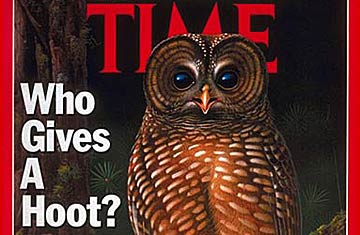
(2 of 9)
All this to protect an owl that stands barely 2 ft. tall and weighs 22 oz. Granted, it is one of the most regal birds of the forest, with its chocolate- color plumage, dappled with white spots, and its enormous eyes, like onyx cabochons, scouring the forest for prey. A fine bird, yes, but it was never really the root cause of this great conflict.
More than a contest for survival between a species and an industry, the owl battle is an epic confrontation between fundamentally different philosophies about the place of man in nature. At issue: Are the forests -- and by extension, nature itself -- there for man to use and exploit, or are they to be revered and preserved? How much wilderness does America need? How much human discomfort can be justified in the name of conservation? In the Pacific Northwest the nation's reinvigorated environmental movement is about to collide head on with economic reality. What happens here will shape the outcome of similar conflicts between ecological and economic concerns for years to come. It will also enhance or diminish U.S. credibility overseas, as America tries to influence other nations to husband their natural resources and protect their endangered species. From Brazil to Japan, the decision will be carefully observed. The stakes are that high.
Environmentalists claim that talk of an economic doomsday is wildly exaggerated and is intended to whip up popular opposition to conservation efforts that threaten industry profits. The skeptics question figures coming from those federal agencies -- the U.S. Forest Service and Bureau of Land Management -- that lease timber rights on public lands and have long been seen as being cozy with the logging industry. Privately, some agency officials concede that the dire economic forecasts were rushed and based on shaky assumptions. Still, they have bolstered industry's attack on the owl- preservation plan and fueled community fears. Already there are signs that those agencies, under directions from the White House, may try to scale down the plan urged by biologists. A joint Forest Service-BLM study indicates that the very fabric holding some communities together would unravel if the biologists' plan were fully implemented. "In severe cases of community dysfunction," says the report, "increased rates of domestic disputes, divorce, acts of violence, delinquency, vandalism, suicide, alcoholism and ( other social problems are to be expected."
In many ways, however, the owl dispute merely hastened an inevitable crisis facing the Pacific Northwest. For decades, the timber industry, driven by the nation's voracious housing needs, leveled private and public land for timber with little regard for long-term consequences. "We've been running an ecological deficit, and the bill has come in," says Jerry Franklin, a research scientist with the Forest Service. "There's going to be pain for owls, for people and for trees." The industry's reforestation practices have markedly improved over the past decade, but the reinvestment is too little too late.
